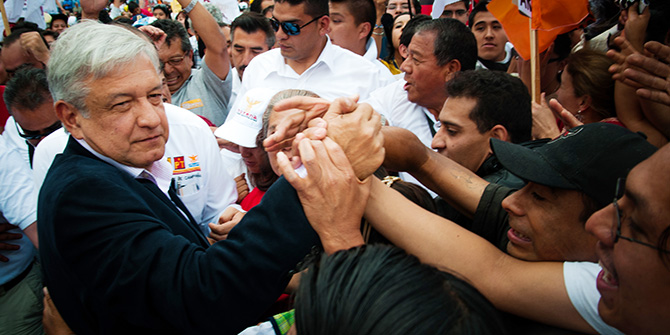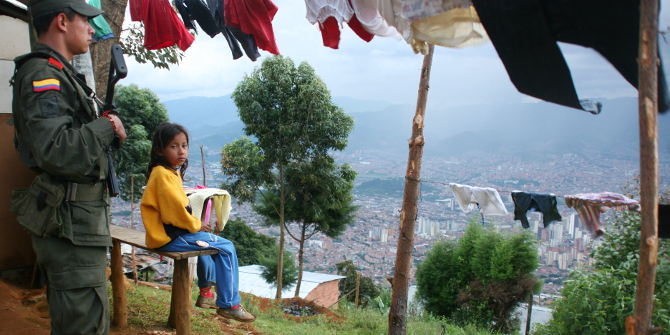The road to gender equality in Chile is both long and narrow. The fact that Gabriel Boric’s rise to power is accompanied by appointing a gender-balanced cabinet is an obvious step, but gender equality is not only restricted to a numerical distribution of positions, says Andrea Gartenlaub (Universidad de Las Américas).
Lee este artículo en español
Gabriel Boric Font is the youngest Chilean politician to take office as president at just 36. One of his first initiatives was to introduce a gender-balanced cabinet. He designated 14 women ministers out of 24. His administration broke another glass ceiling by choosing surgeon Izkia Siches as Interior Minister. This is the first time a female will hold this position in the government.
These are two significant milestones, but this is not the first time a Chilean government has introduced a cabinet with equal representation of men and women. Michelle Bachelet, the first woman to become Chile’s president, did so in 2006. She appointed ten female and ten male ministers each and her decision was a symbolic step in a country with the lowest rates of female participation in decision-making positions in Latin America. Currently, Chile ranks 62nd globally in the UNDP Gender Development Index.
Today, the country runs through ideas of renewal. So applying a gender parity perspective in Gabriel Boric’s government has been read as an obvious step, a necessary one to distinguish itself from previous administrations. But this decision is also expected, particularly given the strength achieved by the local feminist movement. The activists have played a key role in the social movements of the last few years and their accomplishments are enormous. These include the approval of a debated law to decriminalise abortion and the establishment of gender parity in the current Constitutional Convention, which is currently drafting the country’s new constitution. The endorsement given to Boric by Chilean feminists in the contested presidential run-off was key to his election.
The fact that parity is the exception rather than the norm is just one example of what is happening in Latin America in terms of implementing institutional mechanisms to ensure the meaningful participation of women in politics. Argentina was a pioneer and in 1991 pushed a quota law including a minimum of 30% women candidates on its parliamentary lists. A similar rule enforced women’s participation as candidates for deputies and senators from 13% to almost 40% in Chile in 2017. There is a new leap in 2021, with 43.3 per cent of women heading the lists in Senate elections. However, women collected less financial support (34.6% for female candidates for deputies and 37.8% for female candidates for senators) even though they accounted for almost half of the candidacies.
There has been growth in representation in elective positions, but the proportion of women inside ministerial cabinets is more disappointing. According to the latest report by ECLAC’s Gender Equality Observatory, Latin America has had “a discrete increase” with an average of 28% female presence heading ministries. However, in 2018, Costa Rica introduced a cabinet consisting of 55.17% women, including the first black vice president, Epsy Campbell. That same year Colombia presented its first-ever balanced cabinet (although it no longer exists). Similarly, Andrés Manuel López Obrador in Mexico began his term with an equal number of men and women in ministries, although a series of subsequent resignations shifted the balance. Chile joins in 2022 with almost 60% women in Gabriel Boric’s first government.
Equality beyond ministerial positions
This same ECLAC report offers another worrying fact: most of the positions held by women are “concentrated in social areas”, excluding them from political and economic roles. In other words, and despite the reinstatement of gender gaps in public opinion, cultural norms such as women being more apt for caregiving tasks reappear, including when they reach positions of power. Isn’t it frustrating?
Let’s think about it. Until today, women’s presence in the media remains stereotypical: a 2010 study showed how the press highlighted attributes of Chilean women ministers by emphasising their “fragility and sensitivity”. A decade later, gender stereotypes remain a global concern. Recent reports indicate how there are still significant differences in the number of news stories reserved for women candidates. In contrast, the treatment of the news associated with them has a strong focus on their private lives and families.
In recent years, there has been another factor: the growing violence against women on social media, particularly against those women in power, running in elections, or who are visible figures of empowerment. Spreading misinformation, evident misogyny, and threats to their physical integrity are part of everyday life for those working in politics.
Thirty years after that first legislation towards parity in Latin American politics, the road remains narrow worldwide. In 2019, only 22 cabinets had parity globally, and this year, only 17 women will be leading a government. That is 9%, out of 196 countries. Michelle Bachelet, the current UN High commissioner for Human Rights, predicted how slow this will be: “Gender parity in national legislatures would not be reached before 2063, nor would the number of women and men heading Government be equal before 2150.”
This continuing underrepresentation of women pushes us to think beyond affirmative action. Despite being an excellent policy, we must ask ourselves whether gender-balanced cabinets are not just a one-off decision amid societies with persistent inequalities between women and men. What, then, is to be done to ensure that parity is projected beyond government positions?
Achieving gender equality must not only be restricted to numerical equality of positions. Involving women in political life must be linked to a deep cultural change and a new vision of society. We do not just need women’s political participation in top management positions, but this must also be mirrored at different levels, especially in sectors where women’s participation is extremely low, for example in STEM (Science, Technology, Engineering and Mathematics). Gabriel Boric’s administration and others in the world should adopt a gender approach in big politics and in the small programmes that represent local expressions and are closer to the people.
These measures are now urgently needed, especially in the aftermath of the Covid-19 pandemic, which has caused major female unemployment. But also in view of the new emerging threats which threaten liberal democracy as not seen for almost a century. In such an uncertain world order, women must raise their voices and exercise their power.
Notes:
• Translation by Maria Clara Montoya
• The views expressed here are of the author rather than the Centre or the LSE
• Please read our Comments Policy before commenting
• Banner image: Fernando Ramírez (CC BY-SA 4.0)





